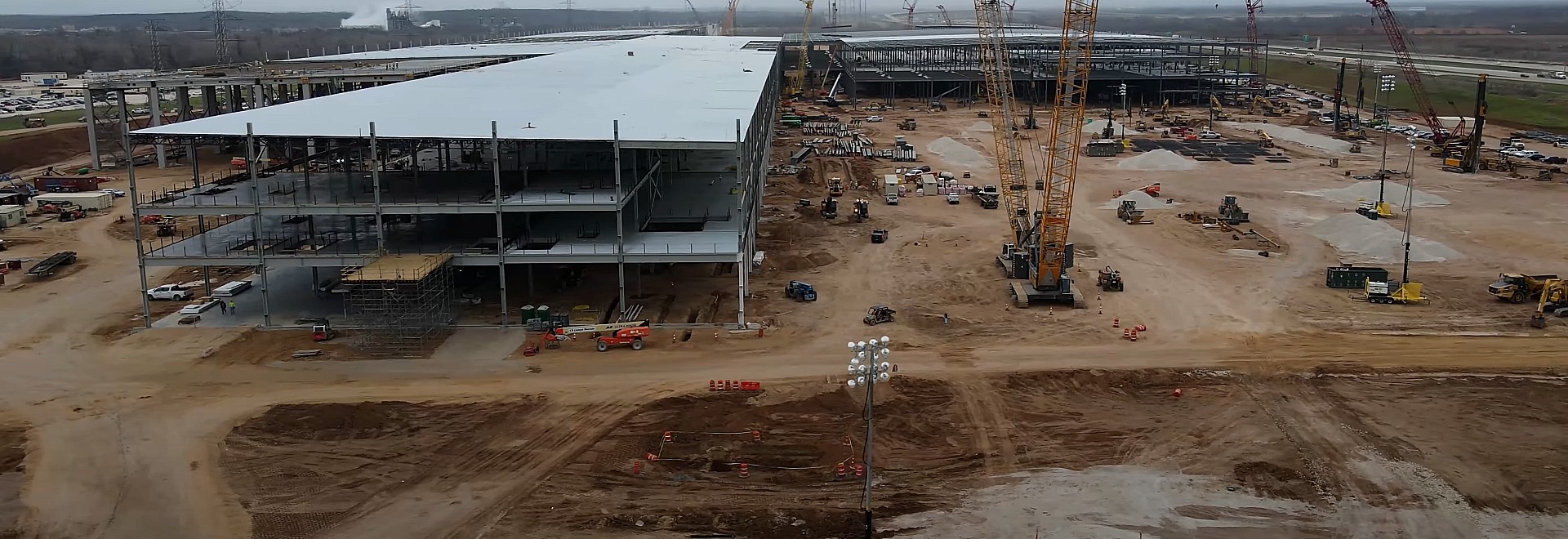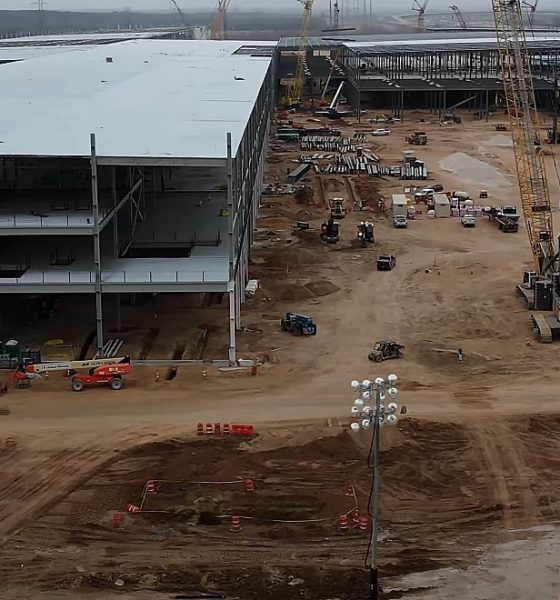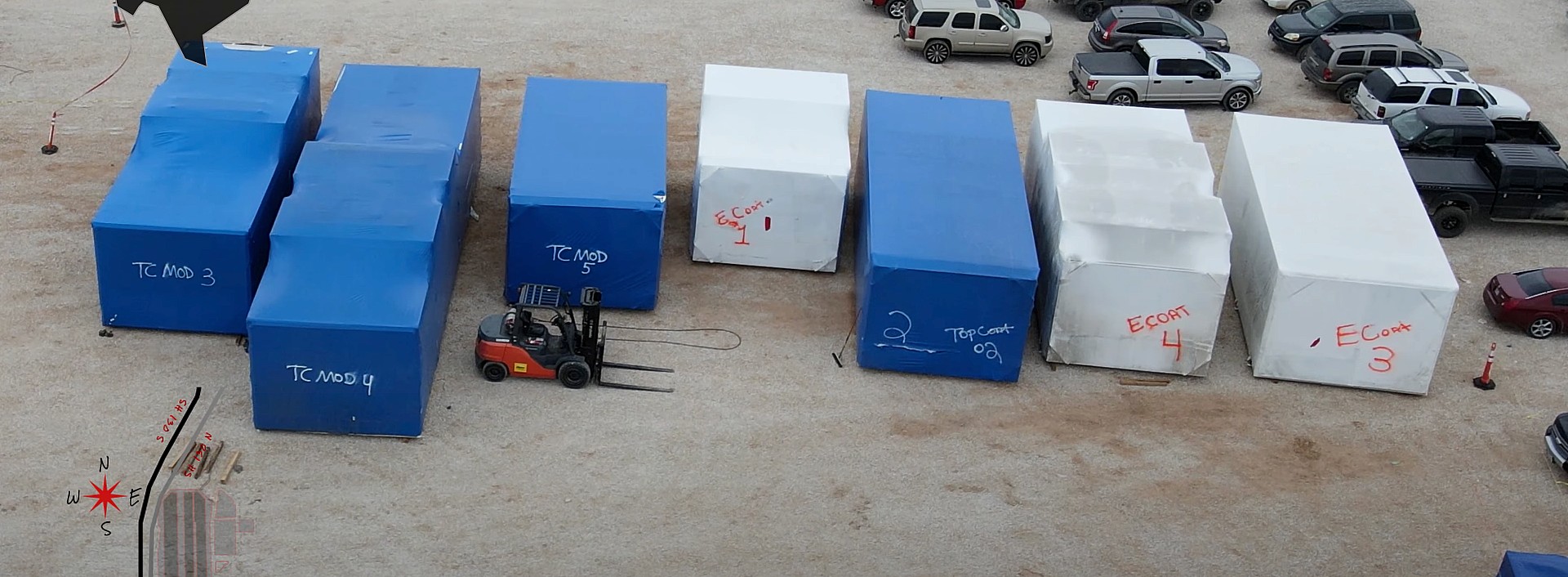

News
Tesla Giga Texas production moves closer as paint shop machinery arrives
The initial production runs at Tesla’s Giga Texas facility are moving closer to reality. A new drone video from a local resident shows Giga Texas’s paint shop facility is set to begin construction soon as paint application machinery has arrived on site.
With Tesla scheduled to begin production at Giga Texas later this year, crews are on-site daily to complete what will be Tesla’s largest production facility to date. One of Giga Texas’s primary focuses is completing the work of the main structure, which appears to be coming along at a reasonably fast pace, something Tesla has displayed at its other manufacturing facilities in China and Germany. With Giga Texas several months into construction, specific areas of the facility are beginning to be erected as the first production runs move closer with every passing day.
A new shipment of containers was spotted at the facility on Monday evening by YouTube channel Terafactory Texas, who spotted seven large boxes that appear to be housing several elements of what will be the Giga Texas paint shop.
Three of the containers say “TC Mod, while three others say “E-Coat.” The final container says “Top Coat,” meaning all seven containers are likely headed to the paint shop as their descriptions align with machinery that would be found within an automotive paint application facility.
E-Coat, or electrocoating, also known as electropainting in some regions, is a process used in automotive paint shops everywhere. For several years, Tesla has used this process as evidence points to a 2012 blog post from the electric car manufacturer.

Credit: Terafactory Texas | YouTube
The company detailed its paint process to ensure quality and corrosion protection:
“First, a Body-in-White is submerged into our pre-treatment bath where the aluminum gets prepared for its first treatment layer. We then dip Model S into a 75,000-gallon tank of advanced electro-coating solution to enhance the appearance of subsequent paint layers. After this e-coat dip, the car goes through a 350° F oven to ensure a “baked on” protection against corrosion.”
E-Coating is a process that has been used for around 50 years, according to ClearClad.com. Originally used to apply an anti-corrosive coating to steel car bodies, the process is now used for various consumer goods like hardware, jewelry, eyeglass frames, and giftware, among several other things. Electrical activity around the vehicle’s surface makes paint resin stick directly to a surface, creating a strong bond between the car and the paint.
TC Mod could stand for “temperature control module,” which would indicate that these containers are carrying HVAC units that are ideal for paint shops. In order for paint to have a strong bond and set correctly on an automotive body, it must be applied and dried in certain conditions. These modules would ensure that Tesla’s paint application process is done at correct temperatures, eliminating any possibility of a weak paint application.
Tesla has worked extremely hard to improve the quality of its paint shops. After paint quality was among the most common complaints from owners, Tesla managed to revamp its facility at the Fremont factory last year as the pandemic slowed production. Several applications acquired by Teslarati showed that Tesla was working to increase fire protection efforts within the paint shop, among some other projects. It worked, as the paint has improved according to some owners, including veteran teardown expert Sandy Munro, who was extremely impressed with the quality of his Model 3’s paint job during a recent drive across the country.
Giga Texas is expected to handle Model 3 and Model Y production for the Eastern half of North America. It will also manufacture the Tesla Cybertruck in either late 2021 or early 2022.
https://youtu.be/N2WG8BoD4c0

News
Tesla FSD fleet is nearing 7 billion total miles, including 2.5 billion city miles
As can be seen on Tesla’s official FSD webpage, vehicles equipped with the system have now navigated over 6.99 billion miles.

Tesla’s Full Self-Driving (Supervised) fleet is closing in on almost 7 billion total miles driven, as per data posted by the company on its official FSD webpage.
These figures hint at the massive scale of data fueling Tesla’s rapid FSD improvements, which have been quite notable as of late.
FSD mileage milestones
As can be seen on Tesla’s official FSD webpage, vehicles equipped with the system have now navigated over 6.99 billion miles. Tesla owner and avid FSD tester Whole Mars Catalog also shared a screenshot indicating that from the nearly 7 billion miles traveled by the FSD fleet, more than 2.5 billion miles were driven inside cities.
City miles are particularly valuable for complex urban scenarios like unprotected turns, pedestrian interactions, and traffic lights. This is also the difference-maker for FSD, as only complex solutions, such as Waymo’s self-driving taxis, operate similarly on inner-city streets. And even then, incidents such as the San Francisco blackouts have proven challenging for sensor-rich vehicles like Waymos.
Tesla’s data edge
Tesla has a number of advantages in the autonomous vehicle sector, one of which is the size of its fleet and the number of vehicles training FSD on real-world roads. Tesla’s nearly 7 billion FSD miles then allow the company to roll out updates that make its vehicles behave like they are being driven by experienced drivers, even if they are operating on their own.
So notable are Tesla’s improvements to FSD that NVIDIA Director of Robotics Jim Fan, after experiencing FSD v14, noted that the system is the first AI that passes what he described as a “Physical Turing Test.”
“Despite knowing exactly how robot learning works, I still find it magical watching the steering wheel turn by itself. First it feels surreal, next it becomes routine. Then, like the smartphone, taking it away actively hurts. This is how humanity gets rewired and glued to god-like technologies,” Fan wrote in a post on X.
News
Tesla starts showing how FSD will change lives in Europe
Local officials tested the system on narrow country roads and were impressed by FSD’s smooth, human-like driving, with some calling the service a game-changer for everyday life in areas that are far from urban centers.

Tesla has launched Europe’s first public shuttle service using Full Self-Driving (Supervised) in the rural Eifelkreis Bitburg-Prüm region of Germany, demonstrating how the technology can restore independence and mobility for people who struggle with limited transport options.
Local officials tested the system on narrow country roads and were impressed by FSD’s smooth, human-like driving, with some calling the service a game-changer for everyday life in areas that are far from urban centers.
Officials see real impact on rural residents
Arzfeld Mayor Johannes Kuhl and District Administrator Andreas Kruppert personally tested the Tesla shuttle service. This allowed them to see just how well FSD navigated winding lanes and rural roads confidently. Kruppert said, “Autonomous driving sounds like science fiction to many, but we simply see here that it works totally well in rural regions too.” Kuhl, for his part, also noted that FSD “feels like a very experienced driver.”
The pilot complements the area’s “Citizen Bus” program, which provides on-demand rides for elderly residents who can no longer drive themselves. Tesla Europe shared a video of a demonstration of the service, highlighting how FSD gives people their freedom back, even in places where public transport is not as prevalent.
What the Ministry for Economic Affairs and Transport says
Rhineland-Palatinate’s Minister Daniela Schmitt supported the project, praising the collaboration that made this “first of its kind in Europe” possible. As per the ministry, the rural rollout for the service shows FSD’s potential beyond major cities, and it delivers tangible benefits like grocery runs, doctor visits, and social connections for isolated residents.
“Reliable and flexible mobility is especially vital in rural areas. With the launch of a shuttle service using self-driving vehicles (FSD supervised) by Tesla in the Eifelkreis Bitburg-Prüm, an innovative pilot project is now getting underway that complements local community bus services. It is the first project of its kind in Europe.
“The result is a real gain for rural mobility: greater accessibility, more flexibility and tangible benefits for everyday life. A strong signal for innovation, cooperation and future-oriented mobility beyond urban centers,” the ministry wrote in a LinkedIn post.
News
Tesla China quietly posts Robotaxi-related job listing
Tesla China is currently seeking a Low Voltage Electrical Engineer to work on circuit board design for the company’s autonomous vehicles.

Tesla has posted a new job listing in Shanghai explicitly tied to its Robotaxi program, fueling speculation that the company is preparing to launch its dedicated autonomous ride-hailing service in China.
As noted in the listing, Tesla China is currently seeking a Low Voltage Electrical Engineer to work on circuit board design for the company’s autonomous vehicles.
Robotaxi-specific role
The listing, which was shared on social media platform X by industry watcher @tslaming, suggested that Tesla China is looking to fill the role urgently. The job listing itself specifically mentions that the person hired for the role will be working on the Low Voltage Hardware team, which would design the circuit boards that would serve as the nervous system of the Robotaxi.
Key tasks for the role, as indicated in the job listing, include collaboration with PCB layout, firmware, mechanical, program management, and validation teams, among other responsibilities. The role is based in Shanghai.
China Robotaxi launch
China represents a massive potential market for robotaxis, with its dense urban centers and supportive policies in select cities. Tesla has limited permission to roll out FSD in the country, though despite this, its vehicles have been hailed as among the best in the market when it comes to autonomous features. So far, at least, it appears that China supports Tesla’s FSD and Robotaxi rollout.
This was hinted at in November, when Tesla brought the Cybercab to the 8th China International Import Expo (CIIE) in Shanghai, marking the first time that the autonomous two-seater was brought to the Asia-Pacific region. The vehicle, despite not having a release date in China, received a significant amount of interest among the event’s attendees.








